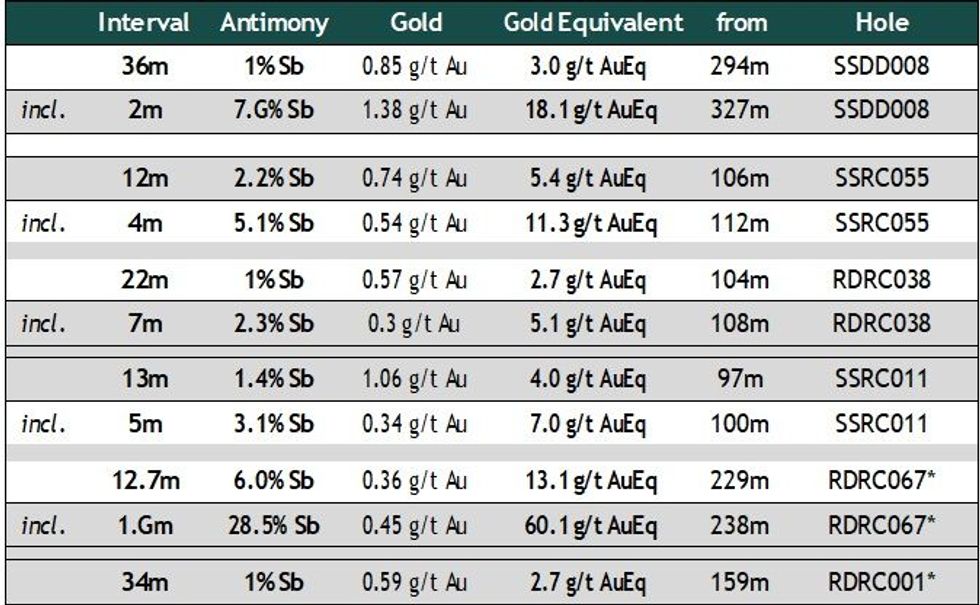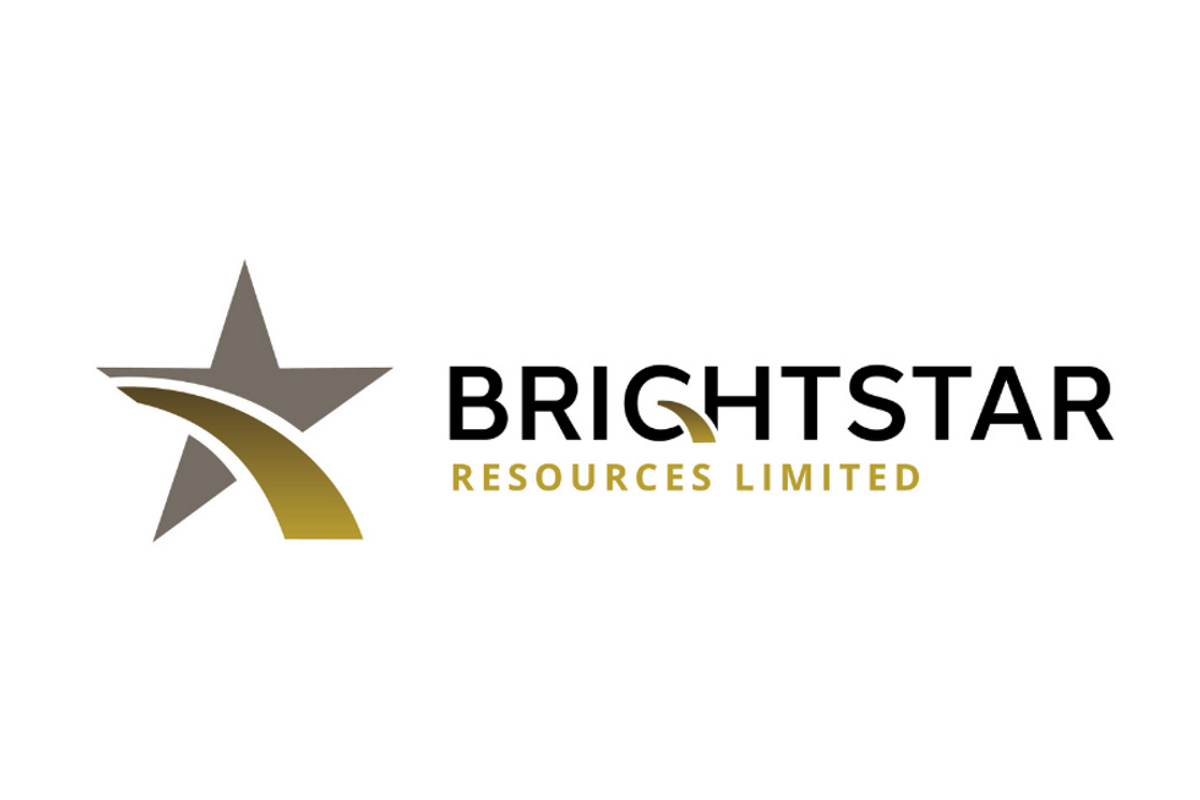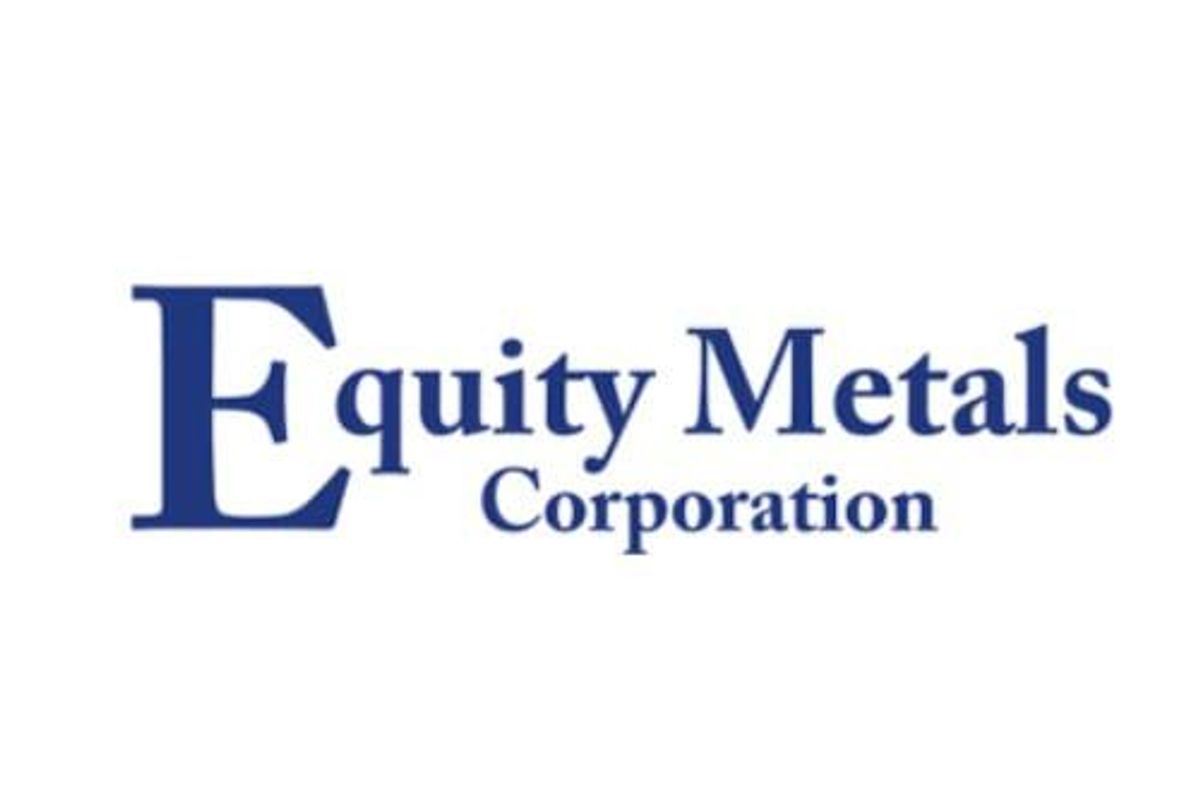
- WORLD EDITIONAustraliaNorth AmericaWorld
Investing News NetworkYour trusted source for investing success
July 02, 2024
Warriedar Resources Limited (ASX: WA8) (Warriedar or the Company) is pleased to provide an update on drilling progress and release the first results from diamond drilling undertaken at the Ricciardo deposit within its Golden Range Project, located in the Murchison region of Western Australia (Figure 1).
HIGHLIGHTS:
- Next phase of drilling activities progressing strongly at Ricciardo and M1.
- Approximately 5,030m RC (29 holes) and 1,420m diamond drilling (16 holes) completed to date.
- The first diamond drilling undertaken at the 2.3km long Ricciardo deposit by any operator in ten years.
- Assay results returned for the first four (4) diamond tails (255m) of the program at Ricciardo have seen all holes intersect significant gold intervals, including:
- 19m @ 4.94 g/t Au from 188m (RDRC039 DD) * includes contiguous final RC result of 4m @ 14.49 g/t from 188m
- 12m @ 6.98 g/t Au from 110m (RDRC040 DD) inc. 3m @ 22.12 g/t Au from 112m
- 16m @ 2.30 g/t Au from 243m (RDRC055 DD) inc. 6m @ 3.13 g/t Au from 252m
- 17m @ 2.38 g/t Au from 264m (RDRC055 DD) inc. 8m @ 4.03 g/t Au from 273m
- Delivers further high-grade extensional success to existing Mineral Resource Estimate (MRE) model below the Silverstone North pit (Holes 40, 55) and infill confidence to MRE below northern end of the Ardmore pit (Hole 39).
- These outcomes build on the growth in high-grade deposit margins delivered at Ricciardo from the significant RC program executed earlier this year.
- Ricciardo sits in the middle of the 25km-long ‘Golden Corridor’ at Golden Range, which hosts six discrete deposits (18 historic pits) that are all open at depth and possess immediate growth potential.
- The ‘Golden Corridor’ is Warriedar’s key exploration focus in 2024.
This is the first diamond drill program at Ricciardo since 2014, when just three (3) diamond holes were drilled by the previous operator.
The results reported in this release are for four (4) (255m) of the 16 (1420m) diamond holes drilled to date. Approximately 2,200m of diamond drilling is planned as part of the current phase of combined RC and diamond drilling at Ricciardo and M1.
The results from these initial four diamond holes extend the high-grade shoot below the Silverstone North pit and infill a previous gap in the high-grade zone of the MRE below the northern part of the Ardmore pit (adding confidence and continuity to the MRE in this area).
These outcomes, while stemming from only a small part of the overall current phase of drilling, continues to demonstrate the outstanding MRE growth potential that exists at Ricciardo and along the broader ‘Golden Corridor’ trend.
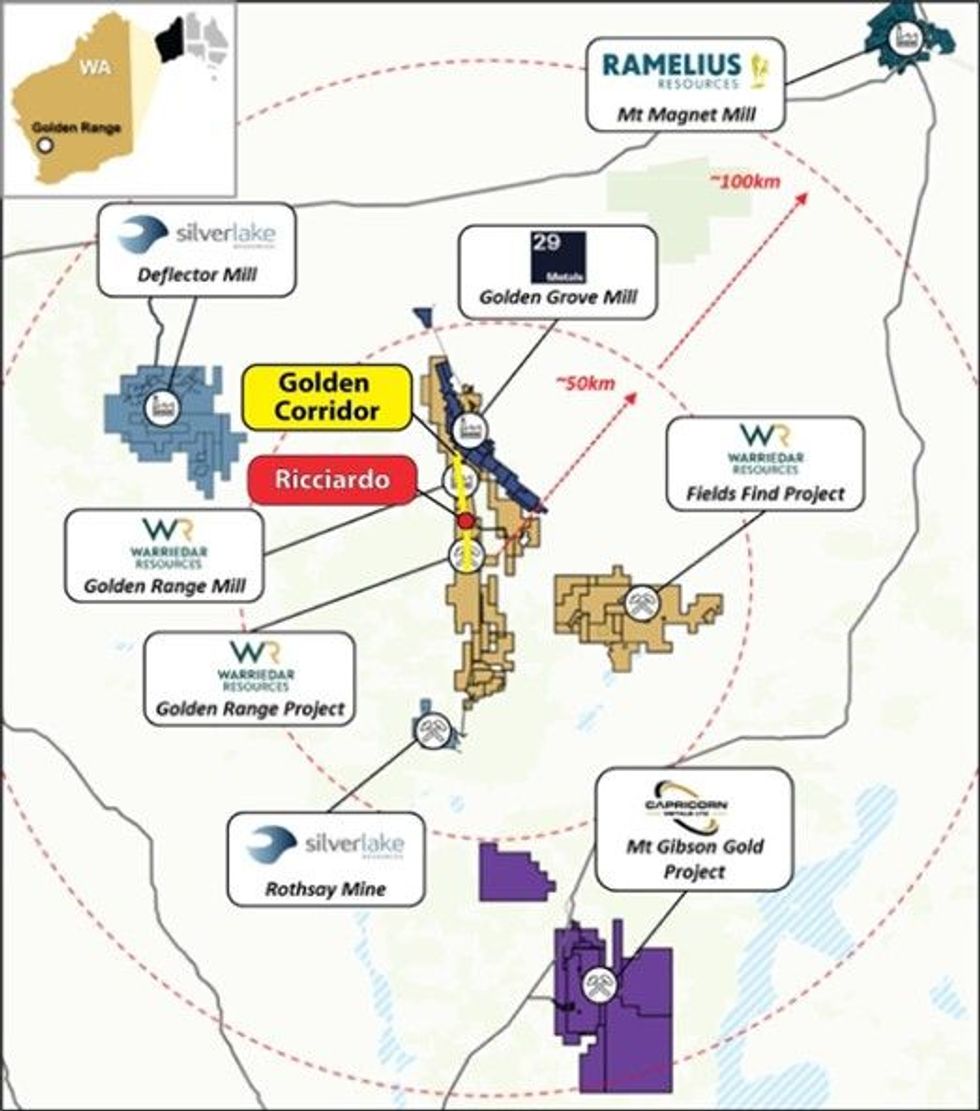
The Ricciardo gold system (within the Golden Range Project) spans a strike length of approximately 2.3km, with very limited drilling having been undertaken below 100m depth. Ricciardo possesses a current Mineral Resource Estimate (MRE) of 8.7 Mt @ 1.7 g/t Au for 476 koz gold.1 The oxide material at Ricciardo has been mined by previous operators.
Click here for the full ASX Release
This article includes content from Warriedar Resources Limited, licensed for the purpose of publishing on Investing News Australia. This article does not constitute financial product advice. It is your responsibility to perform proper due diligence before acting upon any information provided here. Please refer to our full disclaimer here.
WA8:AU
The Conversation (0)
18 November 2024
Targeted Exploration Focus Delivers an Additional 471koz or 99% Increase in Ounces, and a Higher Grade for Ricciardo
Warriedar Resources Limited (ASX: WA8) (Warriedar or the Company) is pleased to report on an updated MRE for its flagship Ricciardo Gold Deposit, part of the broader Golden Range Project located in the Murchison region of Western Australia.
HIGHLIGHTS:
- Updated Mineral Resource Estimate (MRE) for the Ricciardo Deposit (part of the broader Golden Range Project) of 16.44 Mt @ 1.8 g/t Au for 947.5 koz gold.
- Represents a 99% increase in Ricciardo MRE contained gold ounces.
- Proven high-returning exploration with the increased Ricciardo MRE ounces delivered at an attractive all-in discovery cost of only approx. A$16/oz.
- High-quality resource additions given drilling focus on high-grade growth ounces with strong commercial potential.
- The updated Ricciardo MRE comprises:
- 467.5 koz @ 1.6 g/t Au open-pit gold Resource (75% M&I) (optimised pit shell constrained at A$3,300/oz)
- 480.0 koz @ 2.0 g/t Au underground gold Resource
- Critically, the Ricciardo system remains wide open at depth and along strike.
- Total Golden Range Project Mineral Resources now stand at over 1.28 Moz gold, a 58% increase from the previous level.
- This initial outcome validates the excellent potential for further growth within the broader 25km ‘Golden Corridor’ via the ongoing, simple strategy of targeting fresh rock extensions under shallow existing pits.
- RC drilling at the southern end of the ‘Golden Corridor’ targeting high-grade Resource growth is progressing well; 9 holes completed for 1,472 metres to date, assays pending.
Warriedar Managing Director and CEO, Amanda Buckingham, commented:
“This is the result we have been working towards all year. With less than 15,000m of targeted, efficient drilling we have added over 470 koz to the Ricciardo deposit, doubling the Resource.
We are excited by both the outcome itself, and the outlook that it delivers us for the wider corridor of gold deposits. The simple strategy of drilling below shallow open pits to find mineable ounces worked exceptionally well for our producing neighbours. The validity of this strategy is now beyond doubt, for us.
Not only is the Ricciardo system still wide open down-plunge, but the entire 25km long ‘Golden Corridor’ offers similar potential upside from such a relatively simple drilling focus.
In the middle of the infrastructure-rich southern Murchison, and located on existing Mining Leases, the opportunity in front of us is utterly irresistible.”
The Ricciardo Deposit
The Ricciardo Gold Deposit is located on existing mining leases 100% owned by WA8, in the Murchison Region, approximately 300 km east of Geraldton, and 420 km by road north-northeast of Perth. Sitting approximately 8km South of the Golden Range Mill on M59/421, and M59/458, within the Golden Range group of historic open pit mines and deposits.
Discovered in the 1990’s, open pit mining of the oxide resources commenced in 2001, and the plant entered Care & Maintenance twice (between July 2004 and 2009, and May 2010 to mid- 2013). Production was over 300 Koz before finally going into ongoing Care and Maintenance in August 2019.
The Ricciardo deposit is located 90km north of Capricorn Metals’ Mt Gibson Gold Project, 8kms south of the Company’s plant, 26km from the neighbouring Golden Grove processing facility and 40 km northeast of Vault Minerals’ high grade Rothsay gold mine (Figure 1).
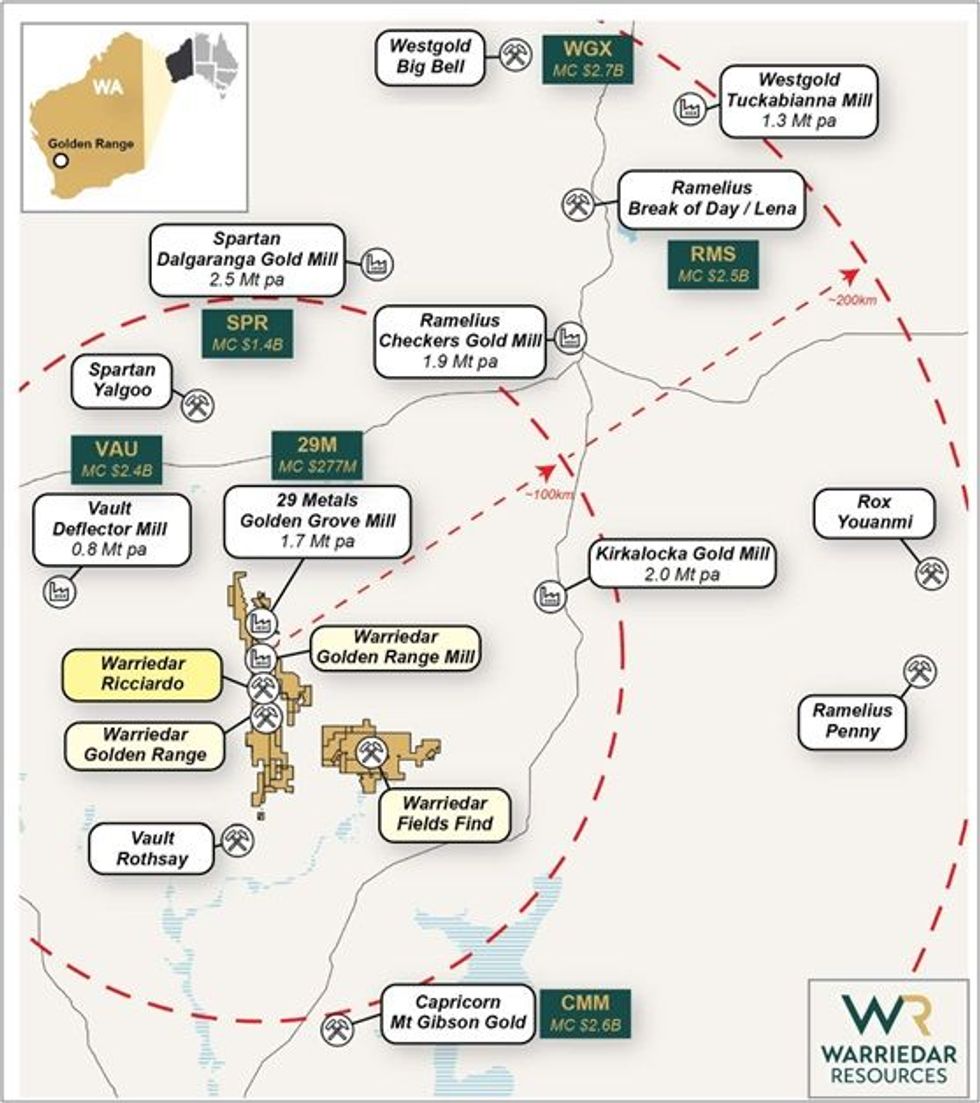
The Ricciardo gold system spans a strike length of approximately 2.3km, with very limited drilling having been undertaken below 100m depth prior to Warriedar drilling. Historical mining operations at Ricciardo were primarily focused on oxide material, with the transition and primary sulphides mineralisation not systematically explored.
Warriedar’s drilling of Ricciardo during CY2024 achieved excellent results, demonstrating high- grade extensions to the resource. The results demonstrated that the previously quantified resource is part of a much larger system.
Warriedar engaged independent mining consultants, Measured Group to update the Ricciardo MRE, previously reported 476Koz gold.1
The Ricciardo Gold Deposit consists of six semi-continuous historical open pit mines along the 2.3 km arcuate stretch of the Mougooderra Shear Zone, running north to south. These mines are named (from north to south) Silverstone North, Ardmore, Copse, Silverstone, Silverstone South, and Eastern Creek (Figure 2).
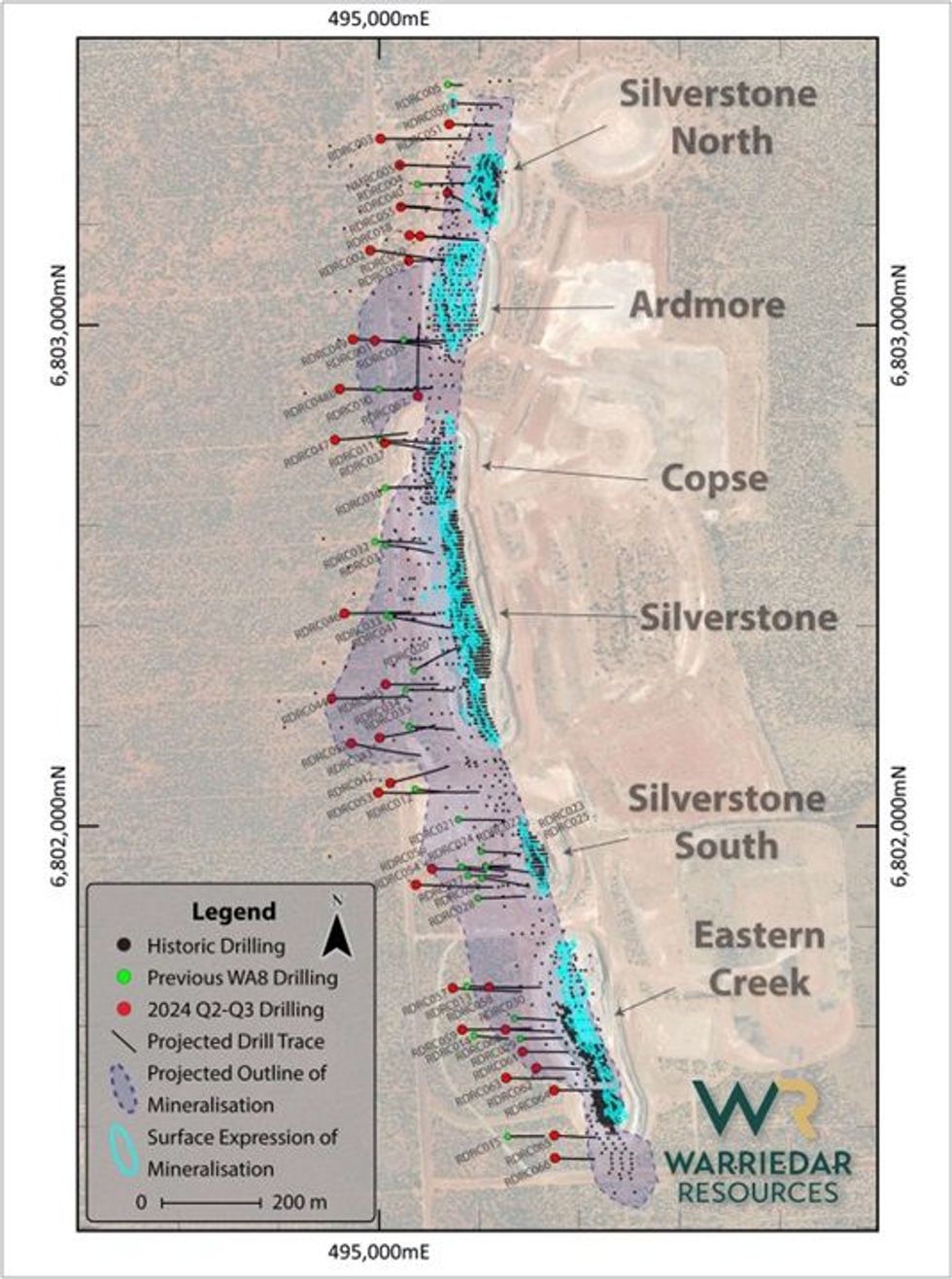
Click here for the full ASX Release
This article includes content from Warriedar Resources Limited, licensed for the purpose of publishing on Investing News Australia. This article does not constitute financial product advice. It is your responsibility to perform proper due diligence before acting upon any information provided here. Please refer to our full disclaimer here.
Keep reading...Show less
30 September 2024
Continued Delivery of High Grade Antimony Mineralisation at Ricciardo
Warriedar Resources Limited (ASX: WA8) (Warriedar or the Company) provides an update on its initial review of the antimony (Sb) potential at the Ricciardo deposit, located within its Golden Range Project in the Murchison region of Western Australia.
HIGHLIGHTS:
- Review of the antimony (Sb) potential at Ricciardo is complete with drillhole assay data confirming Sb mineralisation of significant thickness and grade exists below both the Ardmore pit (previously identified) and the Copse-Silverstone pits (newly identified), representing a potential combined strike length of approx. 1km.
- Multiple significant Sb intervals have been identified (reviewing both historic and WA8 drill hole assays), in addition to results recently released (* indicated below):
- Most of the Sb mineralisation appears to be located above the main gold zone, a distinct metallurgical positive for future processing and economic potential. Similarly to the gold mineralisation, the Sb zones remain wide open at depth.
- Only 11% of historical drill samples at Ricciardo were assayed for Sb. Retained pulp samples from historical holes are currently being tested with pXRF, with those favourable for significant Sb set to undergo laboratory multi element assay.
- An approx. 100kg high-grade sample of antimony mineralisation from Ricciardo has also been dispatched for scoping-level metallurgical testwork.
Warriedar Managing Director and CEO, Amanda Buckingham, commented:
“Following the recent high grade antimony intersections at Ricciardo, our initial review of the broader antimony potential has delivered further promise. An exceptionally high-grade antimony interval, as well as a much wider intersection, are now able to be placed in greater context. This context is a broader volume of antimony, not yet well-defined but with existing drilling showing serious scale and grade potential.
“Importantly, the high-grade antimony appears relatively discrete from higher-grade gold mineralisation, an excellent metallurgical outcome. While it remains early days, we are cautiously optimistic and have commenced initial metallurgical testing for potential processing and antimony recovery.
“While we are excited about this emerging opportunity at Ricciardo, I want to emphasise however that pursuit of this opportunity will be in parallel with our growth-focussed gold drilling at Golden Range, which remains our current core focus.”
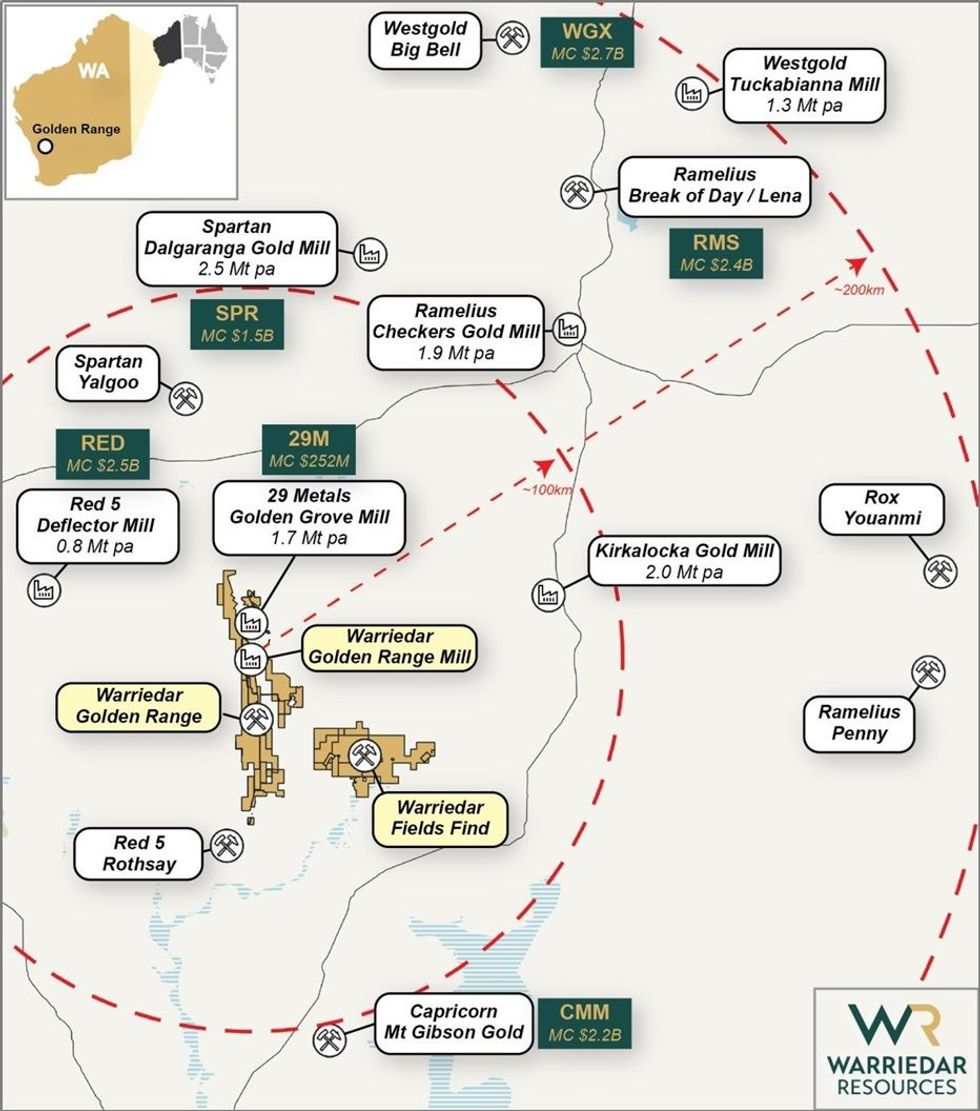
Key Ricciardo context
The Ricciardo gold system spans a strike length of approximately 2.3km, with very limited drilling having been undertaken below 100m depth. Ricciardo possesses a current Mineral Resource Estimate (MRE) of 8.7 Mt @ 1.7 g/t Au for 476 koz gold.1
Historical gold mining operations at Ricciardo were primarily focused on the oxide material, with the transition and primary sulphides mineralisation not systematically explored. Antimony was not a focus of previous exploration, with only about 11% of historic drill holes assayed for antimony.
The gold and antimony mineralisation at Ricciardo is predominantly hosted within intensely altered and deformed ultramafic units. The high-grade antimony-dominant mineralisation occurred later than the main gold events and generally sits above the high-grade gold mineralisation.
Click here for the full ASX Release
This article includes content from Warriedar Resources, licensed for the purpose of publishing on Investing News Australia. This article does not constitute financial product advice. It is your responsibility to perform proper due diligence before acting upon any information provided here. Please refer to our full disclaimer here.
Keep reading...Show less
29 September 2024
Further Strong Extensional Diamond Drill Results from Ricciardo
Warriedar Resources Limited (ASX: WA8) (Warriedar or the Company) provides further assay results from its Golden Range Project, located in the Murchison region of Western Australia.
HIGHLIGHTS:
- All residual assay results received from the recent 2,701m (27 holes) diamond drilling program at Ricciardo.
- Drilling underneath the Silverstone pit confirms the identified high-grade shoot continues at depth and at better than previously modelled grades:
- 13.7m @ 3.27 g/t Au and 0.36% Sb (4.04 g/t AuEq) from 253.3m, inc.
1.2m @ 9.00 g/t Au and 0.00% Sb (9.00 g/t AuEq) from 264.85m (RDRC046) - 22.6m @ 2.11 g/t Au and 0.29% Sb (2.71 g/t AuEq) from 294m, inc.
3m @ 7.22 g/t Au and 0.02 % Sb (7.26 g/t AuEq) from 312m (RDRC044)
- 13.7m @ 3.27 g/t Au and 0.36% Sb (4.04 g/t AuEq) from 253.3m, inc.
- Drilling from the Eastern Creek area, located at the southern end of Ricciardo, confirms down dip continuity with increasing grade and width at depth:
- 7.0m @ 2.54 g/t Au and 0.24% Sb (3.05 g/t AuEq) from 170m (RDRC060)
- 25.0m @ 1.23 g/t Au and 0.17% Sb (1.60 g/t AuEq) from 232m, inc.
6.8m @ 2.37 g/t Au and 0.37% Sb (3.16 g/t AuEq) from 250.2m (RDRC059)
- Update of Ricciardo Mineral Resource Estimate (MRE) on track for Q4 2024.
- Aircore drilling program now in progress at the Golden Range Project targeting an underexplored section at the southern end of the 70-km long shear.
- Further growth-focussed Reverse Circulation (RC) drilling of the ‘Golden Corridor’ scheduled to commence in November.
The assays reported in this release are full results for the final 11 diamond holes (1,021m) from the recent 27-hole diamond tail program at Ricciardo. Results for the first 16 holes of this program have previously been reported (refer WA8 ASX releases dated 3 July 2024, 19 July 2024, 2 August 2024 and 26 August 2024).
Warriedar Managing Director and CEO, Amanda Buckingham, commented:
“This final set of diamond results from the recent Ricciardo drilling have really put a bow on the whole program for us. The broad-based extensional success delivered by this drilling is both real and exciting. The fact that these results are being delivered at what are still relatively shallow down-dip depths, and in such proximity to excellent surrounding infrastructure, also delivers excellent potential for the economic character of the anticipated resource additions at Ricciardo. It is my firm belief that we are just getting started in terms of the opportunity at Ricciardo, let alone within the larger ‘Golden Corridor’ and along the broader mineralised shear.”
Key Ricciardo context
The Ricciardo gold system is located within Warriedar’s flagship Golden Range Project in the Murchison region of Western Australia (refer Figures 1 and 2).
Ricciardo spans a strike length of approximately 2.3km, with very limited drilling having been undertaken below 100m depth. It possesses a current MRE of 8.7 Mt @ 1.7 g/t Au for 476 koz gold. 1 Importantly, historical mining operations at Ricciardo were primarily focused on oxide material, with the transition and primary sulphides mineralisation not systematically explored.
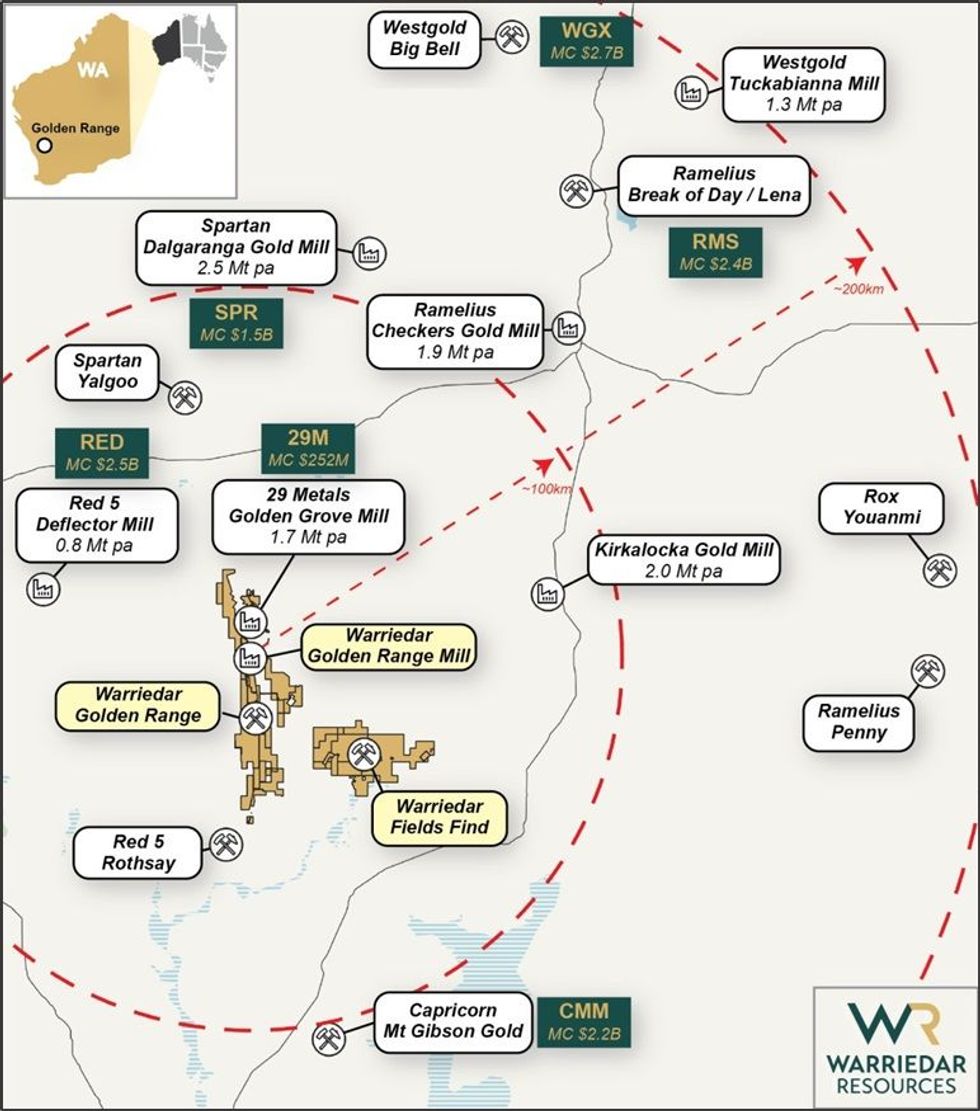
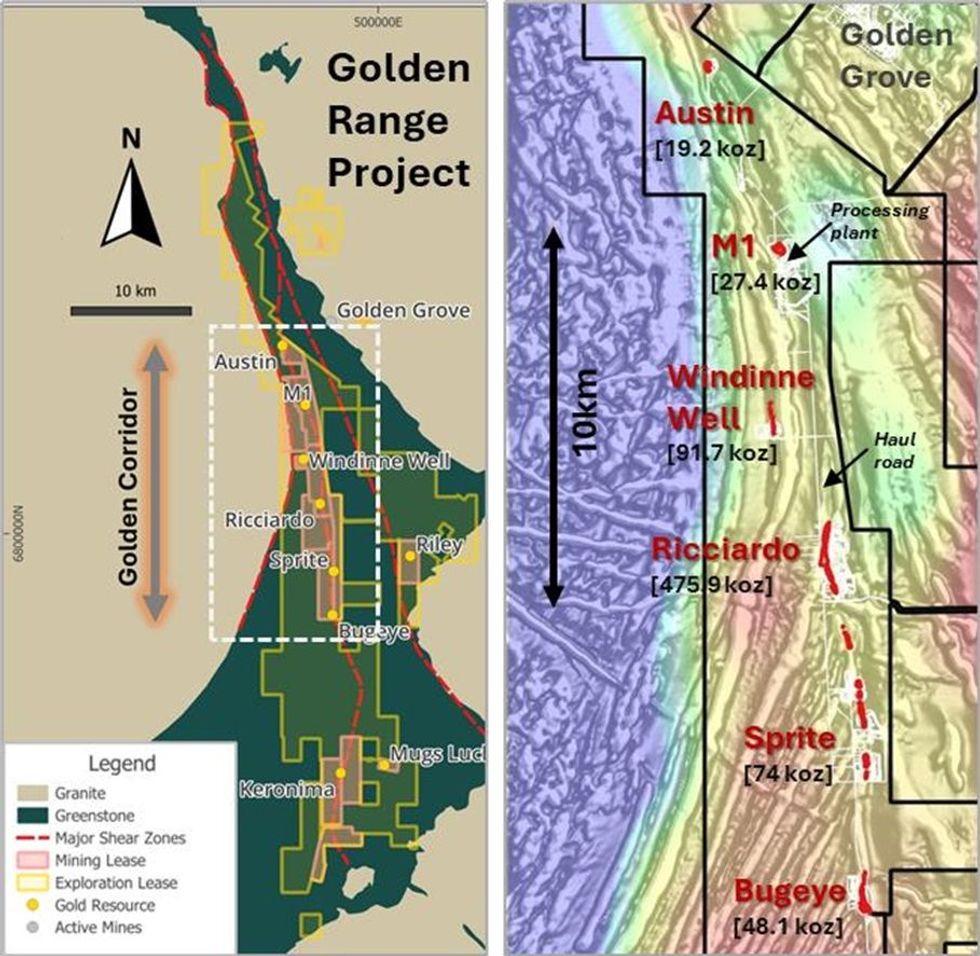
The most recent phase of RC and diamond drilling of Ricciardo has concluded. This release reports on the assays from the final 11 holes of the diamond program. These holes were predominantly located in the southern part of the Ricciardo deposit, focusing on down-dip extension where no previous drilling had been undertaken (refer Table 1 and Figure 3 for drill collar and relevant section locations).
All 11 holes returned significant intersections, delivering a further round of meaningful extensional success from the recent program (refer Table 2). All results are set to be incorporated into an update of the Ricciardo MRE, which remains on track for completion during Q4 2024.
Click here for the full ASX Release
This article includes content from Warriedar Resources, licensed for the purpose of publishing on Investing News Australia. This article does not constitute financial product advice. It is your responsibility to perform proper due diligence before acting upon any information provided here. Please refer to our full disclaimer here.
Keep reading...Show less
26 August 2024
Further Step-Out Gold Success and High-Grade Antimony Discovery
Warriedar Resources Limited (ASX: WA8) (Warriedar or the Company) provides further assay results from its Golden Range Project, located in the Murchison region of Western Australia. The results reported in this release are for a further 6 of the 27 diamond holes drilled in the current program at Ricciardo (6 holes for 1,102m), as well as 2 diamond tails drilled at M1 and Austin (2 holes for 259m). Results for the first 14 diamond holes of the current program were previously reported (refer WA8 ASX releases dated 3 July 2024, 19 July 2024 and 2 August 2024).
HIGHLIGHTS:
- Assay results received for a further 1,102m of diamond drilling at Ricciardo.
- Extremely high-grade antimony (Sb) intersected in multiple holes below the Ardmore pit, including in RDRC067 above the main zone of high-grade gold mineralisation:
- 12.7m @ 4.98% Sb and 0.36 g/t Au (10.92 g/t AuEq*) from 229.2m
incl. 1.85m @ 28.50% Sb and 0.45 g/t Au (60.94 g/t AuEq) from 238.25m
- 12.7m @ 4.98% Sb and 0.36 g/t Au (10.92 g/t AuEq*) from 229.2m
- A wide zone of antimony mineralisation was encountered in hole RDRC001:
- 34m @ 1.0% Sb and 0.59 g/t Au (2.72 g/t AuEq) from 158.80m
- This newly identified and exceptionally high-grade Sb zone, along with the broader antimony potential at Ricciardo, demands prompt follow-up and evaluation.
- Further high-grade gold extension delivered below the Ardmore pit:
- 18m @ 3.41 g/t Au and 0.27% Sb (3.97 g/t AuEq) from 276m (RDRC048B) incl. 4.5m @ 9.90 g/t Au and 0.01% Sb (9.93 g/t AuEq) from 286.5m
- 1m @ 28.31 g/t Au and 2.18% Sb (32.92 g/t AuEq) from 286m (NMRC005)
- 42.6m @ 1.08 g/t Au and 0.05% Sb (1.17 g/t AuEq) from 253.38m (RDRC067)
- ‘Golden Corridor’ diamond drilling now complete, with 31 holes drilled for 3,300m.
- All residual diamond assays expected to be received by late September, with update of the Ricciardo Mineral Resource targeted for Q4 2024.
- Further growth-focussed RC drilling of the ‘Golden Corridor’ scheduled for H2 2024, as well as planned aircore drilling along select parts of the regional shear.
Warriedar Managing Director and CEO, Amanda Buckingham, commented:
“The results for these holes successfully demonstrate further extensional high-grade gold, and for the first time very high-grade antimony zones below the Ardmore pit area.
Given the relative absence of assaying for antimony in historical drilling at Golden Range, we are cautiously optimistic on the potential that might exist here. Moreover, the apparent zonation in RDRC067 is also highly encouraging for any future antimony development potential.
I want to emphasise however that pursuit of this opportunity will be in parallel with our growth-focussed gold drilling at Golden Range, which remains our current core focus.”
* Refer to page 8 of this release for full gold equivalent (AuEq) calculation methodology.
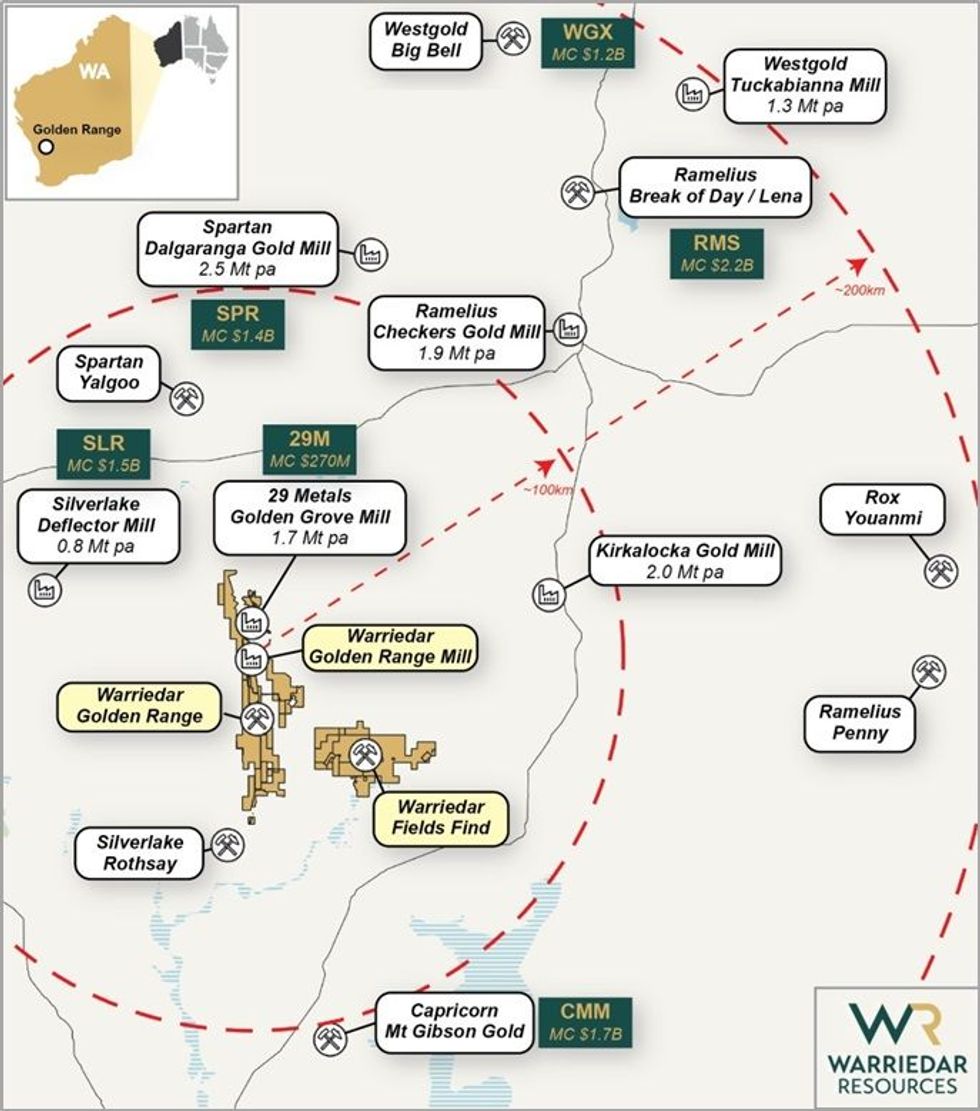
Key Ricciardo context
The Ricciardo gold system spans a strike length of approximately 2.3km, with very limited drilling having been undertaken below 100m depth. Ricciardo possesses a current MRE of 8.7 Mt @ 1.7 g/t Au for 476 koz gold.1 Historical mining operations at Ricciardo were primarily focused on oxide material, with the transition and primary sulphides mineralisation not systematically explored.
Due to the limited number of multi-element assays from historical drill holes at Ricciardo, other mineral potential (outside of gold) has also not been properly evaluated historically.

The gold mineralisation at Ricciardo is predominantly hosted with intensified altered and deformed ultramafic units. It is important to note that the newly identified antimony-dominant mineralisation identified in RDRC067 (discussed below) sits above high-grade gold mineralisation in the same area, and may overprint the earlier gold mineralisation in some areas.
High-grade antimony zone discovery below the Ardmore pit
RDRC067 was designed to drill south to north along strike to better understand the structural controls within the Ricciardo deposit and assess the continuity of the ultramafic unit (Figure 3). All previous drill holes (by Warriedar and previous explorers) have been drilled eastward perpendicular to the known mineralised structure. RDRC067 was considered an important hole by the Warriedar technical team in order to confirm there are no additional structural controls and to provide further confidence in the geological model.
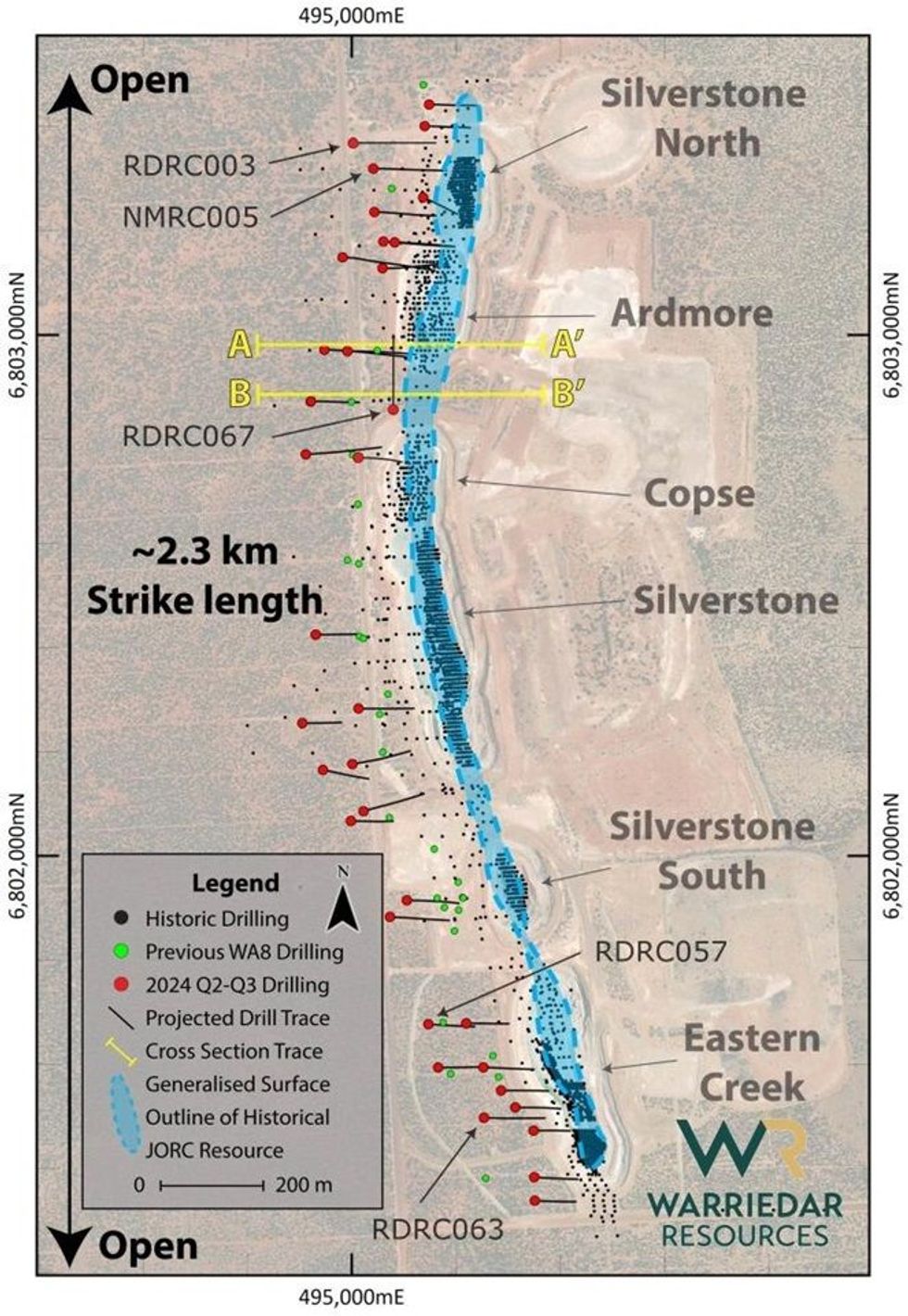
Unexpectedly, RDRC067 intersected significant high-grade antimony mineralisation from 229.2m to 241.9m downhole, returning 12.7m @ 4.98% Sb and 0.36 g/t Au (10.92 g/t AuEq) (Figure 4). Above this high-grade antimony zone, another significant zone was also identified from 183m to 198.1m downhole, returning 15.1m @ 1.42% Sb and 0.42 g/t Au (3.42 g/t AuEq) (Figure 4).
The antimony zones intersected by RDRC067 are interpreted to correlate with a lower grade antimony zone intersected in RDRC038 and RDRC049 (Figure 4). Encouragingly, drillhole RDRC001 returned a wide zone of antimony mineralisation: 34m @ 1.0% Sb and 0.59 g/t Au (2.72 g/t AuEq). Further work is required to determine the geometry and extent of the antimony mineralisation.
RDRC067 concluded at 296.96m downhole depth, within the gold mineralisation domain, as the target depth of the hole had been reached. As RDRC067 is not drilled perpendicular to the Mougooderra Shear, which is the main control of the mineralisation, it is important to note that the intersected thickness does not reflect the true thickness of the mineralisation.
Click here for the full ASX Release
This article includes content from Warriedar Resources, licensed for the purpose of publishing on Investing News Australia. This article does not constitute financial product advice. It is your responsibility to perform proper due diligence before acting upon any information provided here. Please refer to our full disclaimer here.
Keep reading...Show less
01 August 2024
Infill Drilling of Ricciardo Deposit Delivers Significant Gold Mineralisation
Warriedar Resources Limited (ASX: WA8) (Warriedar or the Company) is pleased to provide an update on drilling progress and assay results from its Golden Range Project, located in the Murchison region of Western Australia (Figure 1).
HIGHLIGHTS:
- Assay results for a further two (2) diamond tails at Ricciardo confirm a 77m wide (not true width) mineralisation zone 180m down-dip of the current Resource beneath the Ardmore pit, including a high-grade shoot.
- Significant gold intervals include:
- 7.2m @ 4.51 g/t Au from 232.8m, incl. 3m @ 9.03 g/t Au from 234m
- 10.5m @ 1.53 g/t Au from 218.8m
- 3.9m @ 3.35 g/t Au from 218.8m
- 23.2m @ 1.60 g/t Au from 270.8m
- Mineralisation in this area is structurally complex, extends to a vertical depth of ~ 460m and remains open.
- Ricciardo sits in the middle of the 25km-long ‘Golden Corridor’ at Golden Range, which hosts six (6) discrete deposits (18 historic pits) that are all open at depth and possess immediate growth potential.
- Current diamond drilling program (now extended to 3,000m) at Ricciardo and M1 set to be completed in mid-August, with all assays expected by late-September.
- Update of the Ricciardo MRE is targeted for Q4 2024.
- Further growth-focussed drilling of the ‘Golden Corridor’ scheduled for H2 2024.
The results reported in this release are for a further two (2) of the diamond holes drilled in the current program. Results for the first twelve (12) diamond holes of the current program were previously reported (refer WA8 ASX releases dated 3 July 2024 and 19 July 2024).
The results for these two (2) holes again demonstrate wide infill of the broader Ricciardo deposit at depth, further validating the outstanding Mineral Resource Estimate (MRE) growth potential that exists at Ricciardo and along the broader ‘Golden Corridor’ trend (refer Figure 2).
Warriedar Managing Director and CEO, Amanda Buckingham, commented:
“The outcomes of these two diamond tails are significant, given that they represented substantial depth step-outs under the shallow Ardmore pit. A 77m wide mineralised zone (downhole) with a central high-grade shoot (4.51 g/t), 180m below the MRE is a great result. We don’t fully understand the structural geometry here yet, but we are delighted that the deeper part of hole 49 validates the drill results from a previous explorer – confirming the deposit extends to about 460m vertical depth and retains some good grade (3.19 g/t). Excellent progress.
We continue to drill ahead at Ricciardo as part of the current diamond program, with follow-up growth drilling activities in planning for the remainder of H2 2024.”
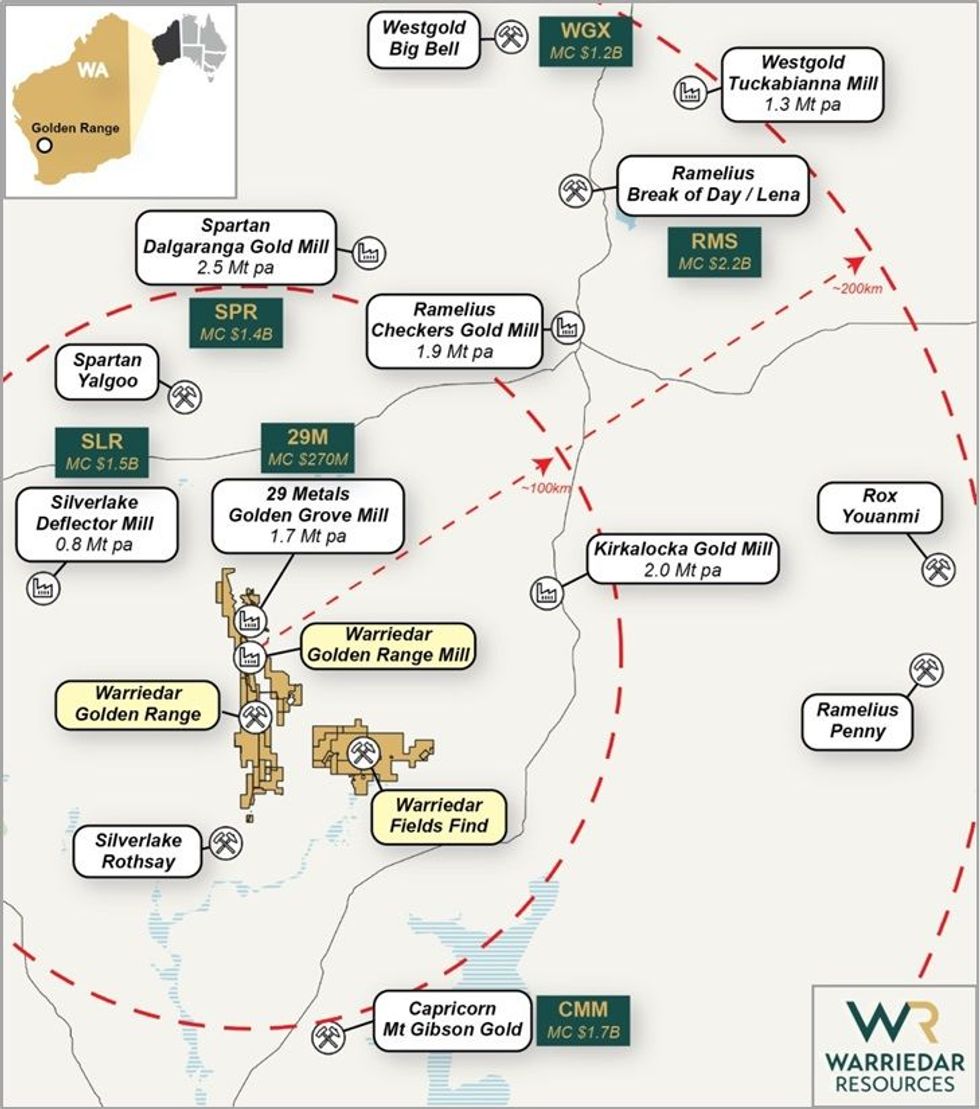
Ricciardo deposit
The Ricciardo gold system spans a strike length of approximately 2.3km, with very limited drilling having been undertaken below 100m depth. Ricciardo possesses a current MRE of 8.7 Mt @ 1.7 g/t Au for 476 koz gold.1 The oxide material at Ricciardo has been mined by previous operators.
Click here for the full ASX Release
This article includes content from Warriedar Resources, licensed for the purpose of publishing on Investing News Australia. This article does not constitute financial product advice. It is your responsibility to perform proper due diligence before acting upon any information provided here. Please refer to our full disclaimer here.
Keep reading...Show less
12h
David Erfle: Silver Staging "Powerful" Breakout; Plus Gold Stocks and Copper Squeeze
David Erfle, editor and founder of Junior Miner Junky, shares his short-term outlook for gold, saying it could see a healthy test of US$3,200 per ounce — or even US$2,950 to US$3,000.
Erfle also shares his thoughts on what's coming for silver and copper prices.
Don't forget to follow us @INN_Resource for real-time updates!
Securities Disclosure: I, Charlotte McLeod, hold no direct investment interest in any company mentioned in this article.
Keep reading...Show less
15h
Equity Metals: Advancing High-grade, District-scale Silver and Gold Assets in British Columbia
Equity Metals (TSXV:EQTY,OTCQB:EQMEF,FSE: EGSD) is rapidly advancing exploration at its 100 percent-owned Silver Queen Project in British Columbia, aiming to expand resources and further de-risk one of the province’s most promising high-grade polymetallic deposits. Situated in the prolific Skeena Arch—home to the historic Equity Silver and Huckleberry mines—Silver Queen hosts an NI 43-101 compliant resource of 62.8 million ounces silver equivalent (indicated) and 22.5 million ounces silver equivalent (inferred). Ongoing drilling in 2024 continues to extend known zones while uncovering new areas of mineralization.
The company is also advancing its newly acquired Arlington Project, a district-scale, never-before-drilled gold-copper-silver asset located in southern BC’s Greenwood Mining Division. With geological similarities to historic producers such as Phoenix and Buckhorn, Arlington is currently undergoing an aggressive 3,000-meter drill program, targeting high-grade, gold-enriched polymetallic mineralization.
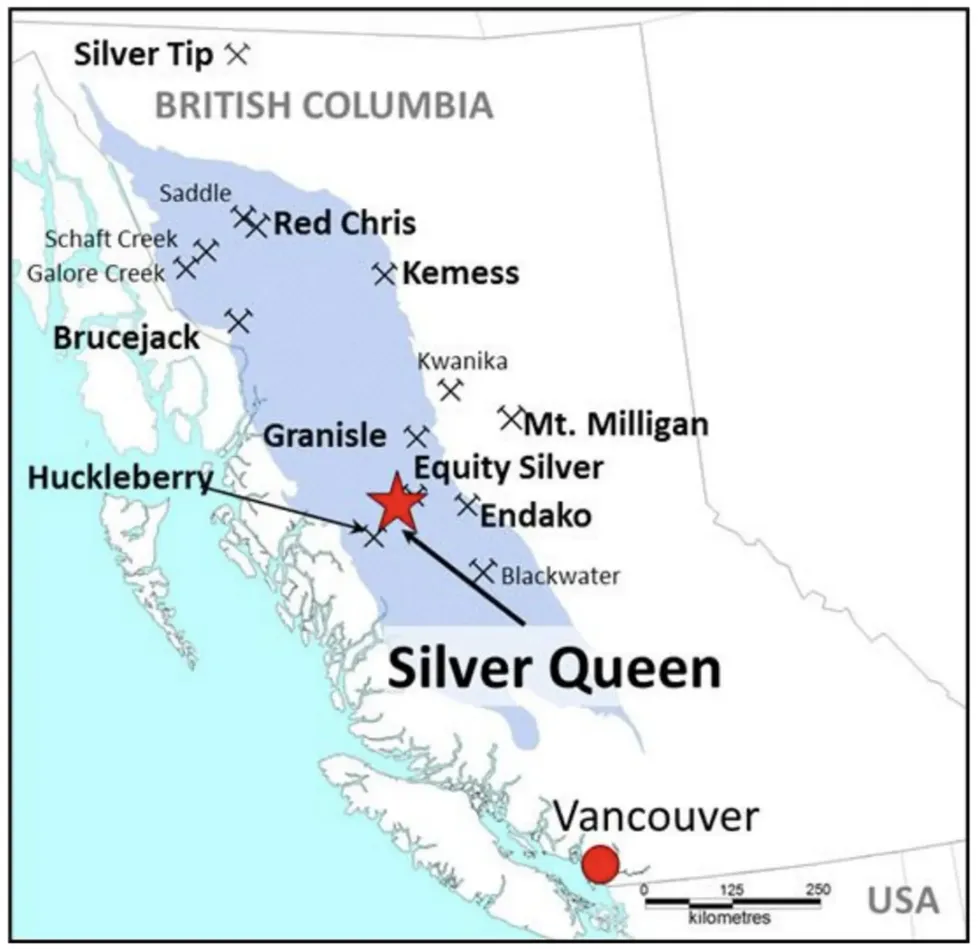
The Silver Queen Project is Equity Metals’ 100%-owned flagship asset, located in the heart of British Columbia’s prolific Skeena Arch, approximately 35 kilometers south of Houston. Covering 18,871 hectares, the property comprises 17 crown-granted titles and 46 mineral tenure claims within the Omineca Mining Division. Strategically positioned among past-producing and active mines, including the Equity Silver Mine, Berg, Endako, and Mt. Milligan, the project is well supported by established infrastructure, with convenient access to roads, power, and rail.
Company Highlights
- Flagship High-grade Project – Silver Queen: Over 85 million silver-equivalent ounces defined in the heart of BC's Skeena Arch mineral belt, surrounded by Tier 1 infrastructure and historical producers.
- New Gold Discovery Potential – Arlington project: A district-scale, early-stage gold-copper-silver system with analogues to major past-producing skarn and vein-hosted mines in the region.
- Fully Funded for 2025: 9,000 meters of combined drilling is underway across both Silver Queen and Arlington with assay results expected to drive news flow through Q3 and Q4 2025.
- Experienced Management and Technical Team: Track record of discovery and mine development across North America, including the Penasquito and Eskay Creek mines and the Wind Mountain project.
- Exposure to Critical and Precious Metals: Balanced portfolio spanning silver, gold, copper and diamonds with optionality in battery materials (silica) and critical minerals.
This Equity Metals profile is part of a paid investor education campaign.*
Click here to connect with Equity Metals (TSXV:EQTY) to receive an Investor Presentation
Keep reading...Show less
01 July
Completed Sale of Lochinvar Coal Project and Royalty Deed
New Age Exploration (NAE:AU) has announced Completed Sale of Lochinvar Coal Project and Royalty Deed
01 July
Munda Gold Mine - Purchase of Mine Camp, Nickel Rights and Water Assets from WIN Metals
Auric Mining Limited (ASX: AWJ) (Auric or the Company) together with WIN Metals Ltd (ASX: WIN) (WIN Metals or WIN) are pleased to announce that the two parties have successfully agreed to the purchase of a package of WIN assets including all nickel and associated minerals rights, water access rights and a fully equipped mining camp all relating to Auric’s Munda Gold Mine.
Highlights
- This milestone agreement considerably enhances Auric’s mining operations at its Munda Gold Mine.
- Acquisition includes a fully equipped mining camp and all related assets six kilometres from Munda Gold Mine.
- All Nickel rights and entitlements will be owned by Auric.
- Sole access and usage of stored water in the 132N pit by Auric.
- Total purchase price $1.4 Million (ex GST), payable in two tranches: Tranche 1 $900,000 paid 30 June 2025, Tranche 2 $500,000 due 31 July 2025.
Management Comment
Managing Director, Mark English, said:“This acquisition gives Auric greater control over our destiny for open pit mining at our Munda Gold Mine.
“Buying all nickel rights from WIN sees us taking another major step forward at Munda. We’ve moved mining at Munda along rapidly this year and are pleased this hurdle to progress our future expansion will be removed.
“There’s not much water around Widgiemooltha, so as part of this transaction, we are acquiring additional access to stored water in the 132N pit. Having adequate water is extremely important for our mining operations. The mining camp is another huge bonus for Auric being located just six kilometres north of our mine.
“We have reached a highly satisfactory agreement for all Auric shareholders,” said Mr English.
WIN Metals. Managing Director and CEO, Steve Norregaard, said:“WIN wish Auric all the best with their Munda gold project development.
“Proposed Nickel mining at Munda was not contemplated in WIN’s 2024 scoping study and as such would have been far into the future for the Mt Edwards Nickel Project. With the outlook of a prolonged subdued nickel price the opportunity to monetise a relatively small portion of the total projects nickel resource base will provide cash for investment into WIN’s gold assets. This is a transaction that makes sense for both companies,” said Mr Norregaard.
The Announcement
The total consideration is $1.4 million, (ex GST) payable in two separate tranches: the first tranche of $900,000 paid on 30 June 2025, the second, $500,000 due on or before July 31, 2025.
Included in the purchase is a fully equipped mining camp located six kilometres north of the Munda Gold Mine sufficient to house the entire workforce. Additional in the deal, Auric has also acquired sole access to all the water in the pit at 132N, just a short distance from the Munda mine.
Auric will at completion own all mineral rights at Munda, except lithium. The lithium mineral rights remain with WIN.
Upon completion of both tranches, on or before 31 July 2025, Auric will have paid WIN a total of $1.4 million (ex GST), for the mining camp, which includes all associated infrastructure such as solar panels, generators, bulk fuel storage, storage containers together with water rights to the 132N pit and all nickel rights and associated entitlements at Munda. The parties have agreed to expedite the grant of miscellaneous licences over the WIN tenements to secure road access as well as the camp.
Click here for the full ASX Release
This article includes content from Auric Mining, licensed for the purpose of publishing on Investing News Australia. This article does not constitute financial product advice. It is your responsibility to perform proper due diligence before acting upon any information provided here. Please refer to our full disclaimer here.
Keep reading...Show less
30 June
Equity Metals
Investor Insight
Equity Metals offers investors exposure to high-grade silver and gold discoveries in British Columbia through a dual-track strategy of expanding its flagship Silver Queen resource and advancing the newly acquired Arlington district.
Overview
Equity Metals (TSXV:EQTY,OTCQB:EQMEF,FSE:EGSD) is fast-tracking exploration at its 100 percent owned Silver Queen project in British Columbia, targeting resource expansion and derisking of one of the province's most prospective high-grade polymetallic deposits. Located within the prolific Skeena Arch near the historic Equity Silver and Huckleberry mines, Silver Queen boasts an NI 43-101 compliant resource of 62.8 million ounces (Moz) silver equivalent (indicated) and 22.5 Moz silver equivalent (inferred), with 2024 drilling extending known zones and identifying new mineralized areas.
Complementing this is the Arlington gold-copper-silver project, a newly acquired district-scale, never-before drill-tested project located in southern BC's Greenwood Mining Division. With analogues to historic producers like Phoenix and Buckhorn, Arlington is being aggressively explored with 3,000 meters of drilling underway, focused on delineating high-grade gold-enriched polymetallic mineralization.
Parameters for the NI 43-101 Compliant Mineral Resource Estimate are in the Appendix and in the EQTY News Release, dated Dec 1, 2022
Together, Silver Queen and Arlington offer a balanced exposure to high-grade polymetallic and gold-rich systems. The former provides near-term resource expansion and development optionality, while the latter opens up district-scale discovery potential.
In addition, Equity Metals holds interests in the Monument and WO diamond properties in the Lac de Gras region (Northwest Territories), proximal to the Diavik and Ekati mines, and the La Ronge silica project in Saskatchewan. These projects offer upside optionality for strategic partnerships or asset sales.
Company Highlights
- Flagship High-grade Project – Silver Queen: Over 85 million silver-equivalent ounces defined in the heart of BC's Skeena Arch mineral belt, surrounded by Tier 1 infrastructure and historical producers.
- New Gold Discovery Potential – Arlington project: A district-scale, early-stage gold-copper-silver system with analogues to major past-producing skarn and vein-hosted mines in the region.
- Fully Funded for 2025: 9,000 meters of combined drilling is underway across both Silver Queen and Arlington with assay results expected to drive news flow through Q3 and Q4 2025.
- Experienced Management and Technical Team: Track record of discovery and mine development across North America, including the Penasquito and Eskay Creek mines and the Wind Mountain project.
- Exposure to Critical and Precious Metals: Balanced portfolio spanning silver, gold, copper and diamonds with optionality in battery materials (silica) and critical minerals.
Key Projects
Silver Queen Project

The Silver Queen project is Equity Metals’ 100 percent owned flagship asset located in central British Columbia’s prolific Skeena Arch, approximately 35 km south of Houston. This 18,871-hectare property consists of 17 crown-granted titles and 46 tenure claims in the Omineca Mining Division. Surrounded by past-producing and active mines, including the Equity silver mine, Berg, Endako and Mt. Milligan, the project benefits from established infrastructure such as roads, power and rail access.
Silver Queen hosts a high-grade polymetallic system featuring silver, gold, copper, lead and zinc mineralization. The project is underpinned by a robust NI 43-101 compliant resource estimate (as of December 2022) consisting of 62.8 million ounces (Moz) silver-equivalent (AgEq) in the indicated category grading 565 grams per ton (g/t) AgEq, and 22.5 Moz AgEq in the inferred category grading 365 g/t AgEq. This includes 3.46 million tons (Mt) of indicated resources averaging 189 g/t silver, 2.13 g/t gold, 0.24 percent copper, 0.6 percent lead, and 3.5 percent zinc, and 1.92 Mt of inferred resources grading 167 g/t silver, 0.82 g/t gold, 0.23 percent copper, 0.5 percent lead, and 2 percent zinc.
The mineralization occurs in multiple steeply dipping epithermal vein systems, subdivided into the No. 3, NG-3, Camp and Sveinson veins. Each exhibits distinct metal zonation – the Camp veins are silver-dominant, while the Sveinson, No. 3 and NG-3 show a stronger gold bias. Bonanza grades have been intercepted at multiple locations, including down-hole drill core intervals assaying up to 56,115 g/t silver over 0.3 metres in recent drill results. High sulphide and low sulphide vein environments have both been identified, suggesting a long-lived and multi-phase mineralizing event.

Since late 2020, Equity has completed 52,877 meters of drilling in 146 holes, targeting extensions and new zones of mineralization. In 2024 alone, four target areas – George Lake, Camp North, No. 3 North and Camp-Sveinson – were tested via 17,209 meters across 42 holes. Drilling resulted in the delineation of a 550-metre strike-length for mineralization in the George Lake target and a 400-metre strike-length for mineralization in the No. 3 North target, as well as several extensions of earlier identified veins in the Camp Deposit and a new discovery in the Camp North target. A 6,000-meter 2025 drilling program will further test these zones with updated modeling and resource growth expected in Q3 2025.
Metallurgical testing completed in both 1988 and 2022 yielded positive recoveries: 83 percent gold, 95 percent silver, 93 percent copper, 91 percent lead, and 98 percent zinc. A follow-up metallurgical program is planned to support preliminary development studies. With extensive underground development (~9 km of historic workings) and proximity to key infrastructure, the Silver Queen project is well positioned for advancement toward economic studies and ultimately, a potential strategic transaction.
Arlington Project

The Arlington project is a 3,584-hectare, early-stage exploration asset located in southern British Columbia’s Greenwood Mining Division, approximately 65 km south of Kelowna. The project sits within the prolific Quesnel Terrane and is accessible year-round via Highway 33 and a network of logging roads. The region hosts several historical producers including the Buckhorn, Phoenix, and Beaverdell mines, which have collectively yielded more than 2 Moz gold, 6 Moz silver and 500 Mlb copper.
Arlington encompasses multiple mineral occurrences and at least four deposit styles across a more than 5 km strike length. Historic and recent surface work has confirmed high-grade mineralization with rock samples returning values up to 11.67 g/t gold, 211 g/t silver, and 3.22 percent copper. The 2025 exploration program, currently underway, includes a 3,000-metre drill campaign primarily targeting the Fresh Pots gold-silver anomaly – a large (2 km x 1 km) intrusion-related gold system delineated by multi-element soil geochemistry and magnetic lows.
Other high-priority targets include:
- Rona Porphyry Target: A copper-molybdenum-gold system with pyroxenite intrusive-hosted mineralization. Rock chip assays have returned >1 percent molybdenum, 0.6 g/t gold, and 32.4 g/t silver. The area is characterized by a large copper-nickel soil anomaly and widespread argillic alteration in adjacent sedimentary rocks.
- Arlington Polymetallic Veins: A structurally controlled vein system with documented historic workings. Highlights include Arlington South (11.67 g/t gold, 3.22 percent copper) and Arlington North (1.86 g/t gold, 1.07 percent copper), suggesting vertical metal zonation and potential for stacked vein systems.
- Skarn and Replacement Targets: Notably at the Bru and Arlington zones, analogous to Buckhorn and Phoenix, where gold-copper magnetite skarns produced over 1 Moz historically.
In early 2025, Equity Metals completed a property-wide airborne magnetic/radiometric survey and LiDAR mapping campaign to refine targeting. Soil and till geochemistry, IP surveying and mapping continue across the license area to delineate follow-up drill targets for 2026.
Management Team
Lawrence Page – Chairman and Director
A seasoned mining executive with over four decades of experience, Lawrence Page has helped finance and develop several major discoveries including Penasquito (Mexico), Eskay Creek and Hemlo. He brings strategic oversight and a deep network within the exploration and capital markets community.
Joseph A. Kizis Jr. – President and Director
With over 40 years of mineral exploration experience, Joseph Kizis has been instrumental in advancing gold, silver and base metal projects across North America. He is also president of Bravada Gold and has played key roles in advancing Wind Mountain in Nevada and Homestake Ridge in BC.
Robert W.J. Macdonald – VP Exploration
Robert Macdonald leads Equity Metals’ technical team and brings extensive epithermal and porphyry system expertise. His past project experience includes Homestake Ridge in BC and Cerro Las Minitas in Mexico, and he is the Qualified Person for all technical disclosures.
Killian Ruby – CFO and Director
As president and CEO of Malaspina Consultants and a former senior manager at KPMG LLP, Killian Ruby brings financial discipline, governance strength and tax expertise. He also serves as CFO for several junior resource companies.
John Kerr – Director
A professional engineer with five decades of exploration experience, John Kerr has contributed to the discovery and development of projects such as Santa Fe and Mindora in Nevada, and Frasergold in BC.
Courtney Shearer – Director
Courtney Shearer has served in executive and advisory roles with multiple Canadian mining companies, including San Gold Corporation, where he led strategic evaluations and project planning initiatives.
Arie Page – Corporate Secretary
Arie Page provides legal and corporate compliance support and has served as corporate secretary for numerous public companies within the Manex Resource Group.
Appendix:
Silver Queen Mineral Resource Estimate (NI 43-101 Compliant, Dec. 1, 2022) (C$100 NSR cut-off)
- The current Mineral Resource Estimate was prepared by Garth Kirkham, P.Geo., of Kirkham Geosystems Ltd and Eugene Puritch, P. Eng., FEC, CET and Fred Brown, P, Geo. of P&E Mining Consultants Inc. (“P&E”), Independent Qualified Persons (“QP”), as defined by National instrument 43-101.
- All Mineral Resources have been estimated in accordance with Canadian Institute of Mining and Metallurgy and Petroleum (“CIM”) definitions, as required under National Instrument 43-101 (“NI43-101”).
- Mineral Resources were constrained using continuous mining units demonstrating reasonable prospects of eventual economic extraction.
- Silver and Gold Equivalents were calculated from the interpolated block values using relative process recoveries and prices between the component metals and silver to determine a final AgEq and AuEq values.
- Silver and Gold Equivalents and NSR$/t values were calculated using average long-term prices of $20/oz silver, $1,700/oz gold, $3.50/lb copper, $0.95/lb lead and $1.45/lb zinc. All metal prices are stated in $USD. The C$100/tonne NSR cut-off grade value for the underground Mineral Resource was derived from mining costs of C$70/t, with process costs of C$20/t and G&A of C$10/t. Process recoveries used were Au 70%, Ag 80%, Cu 80%, Pb 81% and Zn 90%.
- Grade capping was performed on 1m composites for the No. 3 and NG-3 veins and whole vein composites for the Camp and Sveinson veins. For the No. 3 and NG-3 veins Inverse distance cubed (I/d3) was utilized for grade interpolation for Au and Ag and inverse distance squared (I/d2) was utilized for Cu, Pb and Zn. Inverse distance squared (I/d2) was used for all metals in the Camp and Sveinson veins.
- A bulk density of 3.56t/m3 was used for all tonnage calculations in the No. 3 and NG-3 veins. A variable density with a 3.15 average was used for the Camp and Sveinson veins.
- Mineral Resources are not Mineral Reserves until they have demonstrated economic viability. Mineral Resource Estimates do not account for a Mineral Resource’s mineability, selectivity, mining loss, or dilution.
- An Inferred Mineral Resource has a lower level of confidence than that applying to an Indicated Mineral Resource and must not be converted to a Mineral Reserve. It is reasonably expected that the majority of Inferred Mineral Resources could be upgraded to Indicated Mineral Resources with continued exploration.
- All figures are rounded to reflect the relative accuracy of the estimate and therefore numbers may not appear to add precisely.
Keep reading...Show less
Latest News
Latest Press Releases
Related News
TOP STOCKS
American Battery4.030.24
Aion Therapeutic0.10-0.01
Cybin Corp2.140.00


